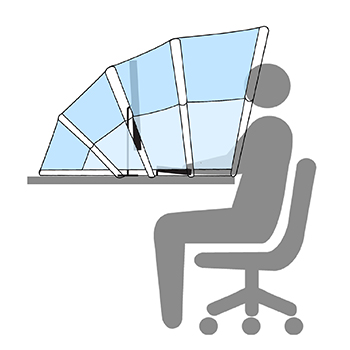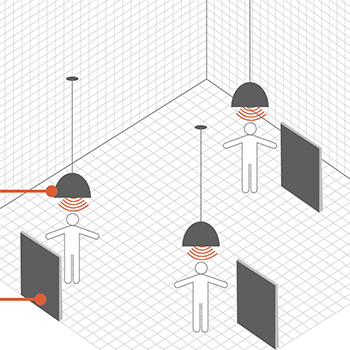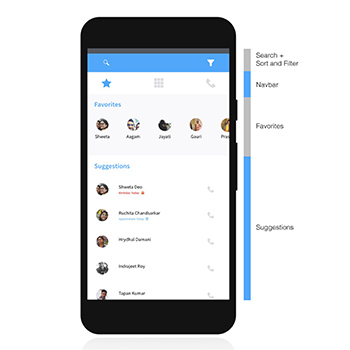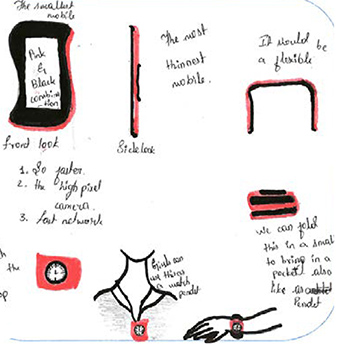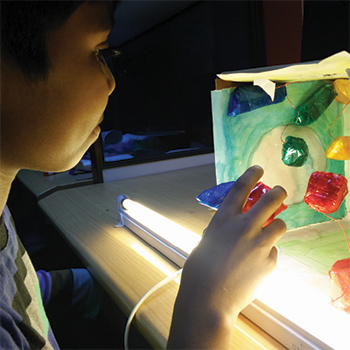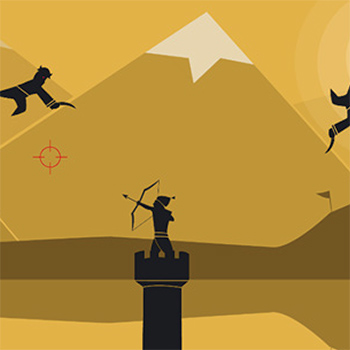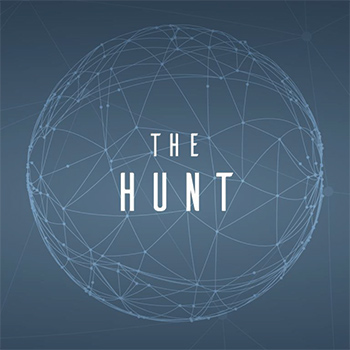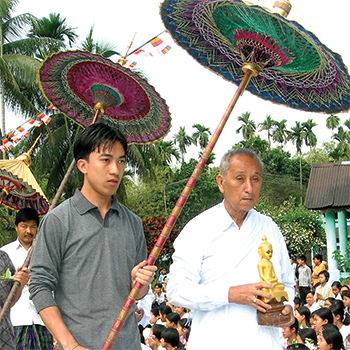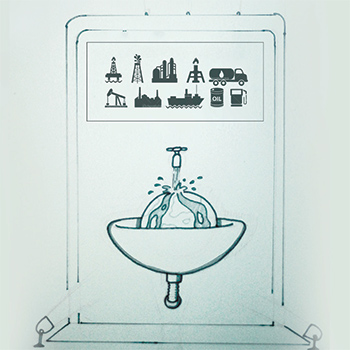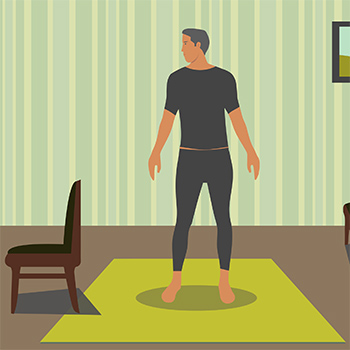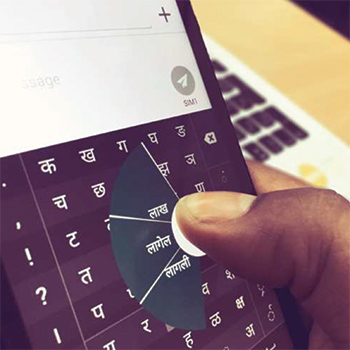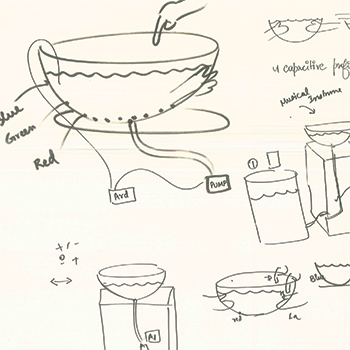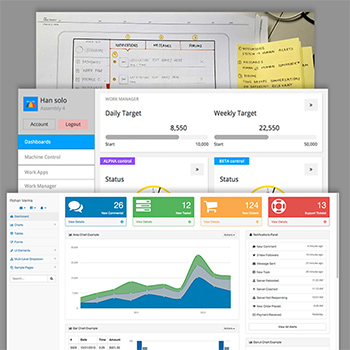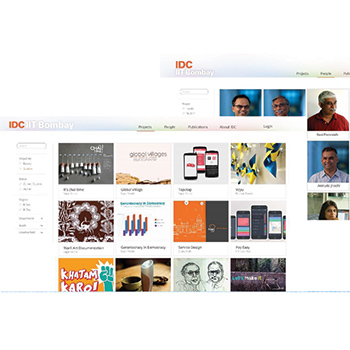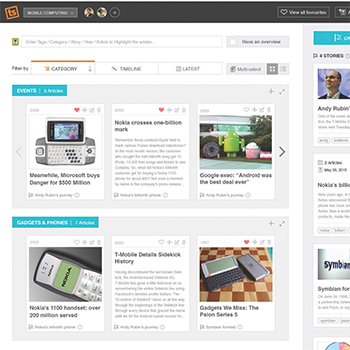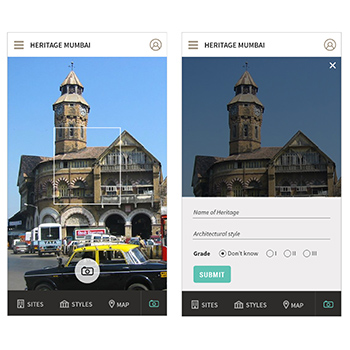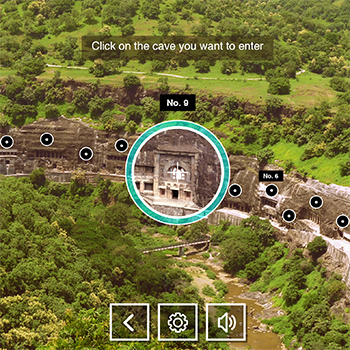Interaction Design
Batch 2014-2016
(40 items)
Interaction DesignBatch 2014-2016
(40 items)
(40 items)
Assistive device for people with cerebral palsy
by Sajal Nagwanshi
by Sajal Nagwanshi
The objective of the project is to design an assistive device for people with cerebral palsy (CP). The primary objective of the device is to help people communicate their basic needs to their caregivers. Apart from communication, the device would also be used for training their motor skills, participating in recreational activities, and teaching various topics. The popular input devices like a mouse or keyboard require fine motor skills to give input to computers, which is not possible for people with spastic CP. The solution proposed here is a tangible device that is pressure-sensitive. It takes the input signal of gross motor movement, like the tapping of feet or hands, and converts it into meaningful information. It can recognise the position and the pressure of fingers touching it. This device can be attached to any computer and used for various applications. The solution describes how the users would interact with the device for applications of motor skill development, communication, and recreational activities. For the purpose of testing the concept, a person with cerebral palsy was chosen. He has quadriplegia, and the only part of his body that he can voluntarily control is his left toe. Therefore, the present prototype of the device was made to be operated by the left toe.
Details >>Seeing the Sound and Sounding the Scene
by Saourabh Pateriya
by Saourabh Pateriya
Seeing the Sound and Sounding the Scene is rhythmical and beautiful at the same time. This sounds poetic but makes utmost sense if you read carefully. In this project, we figured out the relation of visuals with sound and vice versa as individually they look and sound empty. Aim of this project was to explore the relation between “sound and scene” and how they complement each other. Exploration was done by documenting some movies after seeing and analysing them and talking to industrial expert, Oscar award winner sound designer “Glenn Freemantle” who also owns sound24, a UK based sound design form. He has done more than 70 films till date. By talking to him, we got some out of the ordinary insights giving interesting ideas and leaving us with lot of other questions.
Details >>Creating Flexible Workspaces
by Saourabh Pateriya
by Saourabh Pateriya
The team from Industrial Design Centre, IIT Bombay comprising of Edu Mohan, Jaison Jacob, Naveed Ahmed and Sourabh Pateriya visited Institute of Ergonomics (IAD), Technical University of Darmstadt, Germany, on a Student Exchange Program during May-June 2013. IAD specializes and carries out continuous research in the field of ergonomics with focus on vehicle ergonomics, work organization and production ergonomics. During the 6-week exchange programme, the team worked on a project and various workshops. While the project was three weeks long, the workshops usually were as short as two or three days. The workshops were randomly distributed over the 6-week period. Students from Interaction Design – Jaison, Naveed & Sourabh – worked on the project, the details of which are mentioned below. The project, Creating flexible workspaces in the IAD context, was completed by the team from Interaction Design over a period of three weeks. The workshops included learning new methods of decision making, design explorations, designing games, attending talks and providing design recommendations to a variety of project modules. The content in this report has been structured and divided based on the projects and workshops done. They have been ordered according to the duration and amount of work done during each assignment
Details >>Awareness for politics and politicians
by Saourabh Pateriya
by Saourabh Pateriya
There is a gap between the reach of people and politicians in this country. Very few people know about politicians who are surrounding them and about the political issues happening around. In a democratic nation like India, everybody gets the opportunity to vote and elect their leaders. When elected politicians come into power, many of them misuse it and huge scams, corruption are the result of such irresponsibility towards the faith of people. Same people when try to get information about their acts feel helpless because information sources are very unapproachable. Lack of accountability and transparency in the system is making it difficult for people to get answers. There is strong need of awakening and making citizens of this country realize that their unity and attentiveness can result into a new clean political era. This project aims to make people aware about political happenings, bring them together to talk about it resulting in transparent political system. There is very less technological and design intervention in this domain, this project looks for the possibilities of it. Introduction of new media can add another dimension facilitating people to stay connected and alert about the political happenings. By understanding how people get information of politicians, discuss using different communication channels, raise an issue, a better modal can be thought of.
Details >>Enabling remote participation and coproduction of events
by Saourabh Pateriya
by Saourabh Pateriya
As many people and communities continue to be isolated in their own places and never go out to participate in events and festivals due to some factors, they are missing out lot of things in their lives. This project has looked for the possibilities of how these people can attend events and connect to each other remotely. Giving specific direction to this wide spectrum of problem was important and hence specific problems were chosen to forward. We came up with a platform called “Human Connector”, by using which people can attend events remotely. Not only attend, this platform gives them power to organize event and make it available to remote audience easily. Human Connector makes use of Crowdsourcing and makes content from various people available to everyone. By this, we will be able to attend an event live or even store it forever. So, even if you miss an event, you can attend it later on by using Human Connector platform. This project is a wide spectrum of possibilities and every person might attack this whole problem differently (explained in “possibilities section)”. The path chosen finally is selected only after trying out multiple paths and after rigorously having extensive brainstorming session with faculties
Details >>Visualisation of Street Sounds of Kolkata : An immersive virtual experience
by Akshay Kore
by Akshay Kore
The project that initially started with the aim of visualising the street sounds of Kolkata turned into the creation of an immersive exploration of the city by means of virtual reality. This was done through a series of ideas and design decisions based on the experience, scalability, replicability, and in many cases, cost, time, and constraints of current technology. The creators went on a 15-day journey of collecting data for various aspects of the city, which included ambient and characteristic sounds, images, textual information, and 360-degree views. The creators wanted to evoke nostalgia in those who live in Kolkata or have previously lived there; they wanted them to experience parts of the city before visiting them for "real."The medium's creators believe that VR as a medium has a lot more to develop before it gives a "real experience" of the real world. Yet it is great to give one a partial experience of the place. This partial experience is created through a virtual reality application that enables one to experience certain parts of the city from the comfort of their locale.
Details >>Visualization for Mumbai’s Data
by Akshay Kore
by Akshay Kore
Our governments collect vast amounts of data about us and our surroundings. A major part of this data is accessible in the public domain. This data shapes our cities, our villages. It is responsible for policies that affect us. And yet we know so little about it. This data tells stories of times gone by, it is a testament to our history. We can backtrace our paths and see where did we go wrong or better yet, where were we right. A part of why we know so little is because the data does not speak to us nor can we make sense of numbers in tabular formats very easily. It does not come to us in a palatable form. We are visual beings by nature and it is much easier for us to see visuals; may it be a photograph or a graph. Those lines and pixels in two dimensional space tell us of a story that words alone could never describe that well. Visualization of this vast amount of data becomes important in a way that it tells us much more than just numbers could ever tell us. It tells us about the rise and decline of our society, trends and maybe even help us predict what is to come. Maybe it could prevent a disaster or tell us about past ones so that we learn. Before telling of a story of our cities comes the knowing of our cities. Before the visualization comes the data. This project is the first part of the project titled ‘Visualization for Mumbai’s Data’ and focuses on collection and partial analysis of the quantifiable data of the city of Mumbai. The overall project aims to set an example
for presenting the data about our cities at large.
Details >>Data Visualization for Mumbai
by Akshay Kore
by Akshay Kore
Our governments create and release vast quantities of data about us and our surroundings by means of the census, budgets, human development reports, LAN use studies, etc. This data is released in the public domain and is regularly accessed and used by policy and decision-makers in both the public and private domains. Data visualisation allows for data analysis, especially when large amounts of data are available. Data visualisations are frequently used by these decision- and policy-makers.The visualisation of data done by these individuals or groups is most often done with a purpose in mind. However, insights can come from anywhere, in seemingly disparate correlations between two or more datasets. Accessing these datasets is often difficult due to the scattered nature of our government bodies, and even after access is gained, the datasets come in different tangible and intangible file formats, making direct use of these datasets for visualisation a difficult and often laborious task. With the city of Mumbai as an example, this project aims to enable an easy way to visualise the city’s spatial data. This is done by means of a web-based application called the Mumbai Data Visualization Tool. The higher goal is to enable faster and better decision-making by means of data visualisation and set an example for all city governments in the country.
Details >>PhonBk: Design of a smarter context based Phonebook visualization for mobile devices
by Akshay Kore
by Akshay Kore
With the advent of smartphones and social media it is common to have over a one thousand contacts in one’s phonebook. There is a problem of information design for management of contacts since the modern phonebook contains phone numbers as well as details for other mediums of communication such as email, Facebook, WhatsApp, etc. Despite the advancement in computing power of our phones, our phonebooks have been slow to adapt. Most current phonebooks are based on the same design of the phonebook for a feature phone. In the vast sea of contact information, how does one find which are the most relevant contacts? Data from Primary studies, user studies and secondary research points heavily towards the Pareto Principle which suggests that only 20% of the information is important. The same principle can be applied to the task of contact visualization as well. Importance of a contact can be determined from usage patterns of calling, location information as well as personal details of the contact. This context aware data can be used for contact suggestion. It was found in the primary and secondary research that certain features of the phonebook such as favorites and groups are redundant and not many users seem to be using them. A preliminary design was created which augmented the structure of the existing phonebook with a contact suggestion widget. The suggestions in the widget are updated periodically based on the user’s location, time, day and date. A heuristic evaluation of the idea presented the need to use realistic data. Problems were found with navigation in the existing phonebook and the text input based search of contacts was found to be redundant. It was also thought that the suggestions widget might be beneficial in scenarios when a very small screen real estate is available in the case of wearable devices. The phonebook could also encourage exploration of contacts. The Phonebook is a ubiquitous application in the smartphone and redesign of the phonebook need not be a complete overhaul. A final idea was developed through a series of smaller design interventions in the navigation, microinteractions and the user interface of the phonebook application. The concept named ‘PhonBk’ was designed around the goal of finding the most important contact at the moment. This is done by means of a suggestion widget in the home screen of the application, a frequency based suggestion in the contact list and an advanced navigation feature which enables filtering and sorting of the call log. An evaluation was conducted with 7 users to check for the accuracy of suggestion of contacts and the advanced navigation feature was evaluated for its usability. It was found out that the suggestions of contacts was fairly accurate, however the usability of the same needs to be tested. In case of the advanced navigation feature, it was found that users faced great difficulty in the usability. The advanced navigation feature was redesigned based on the inputs from the usability evaluation. The PhonBk project is an attempt to re-design the phonebook application which is already ubiquitous across all current smartphones. The project attempts to make important incremental improvements in the current phonebook by means of smarter suggestions based on the context of the user, through an advanced sorting and navigation feature and other design interventions in the visualization as well as organization of contacts. The end goal is to make improvements in the fundamental task of finding the most relevant contact at any moment.
Details >>Exploring sculptural works in clay
by Dani K Raju
by Dani K Raju
The aim of this special project is to explore the processes involved in sculpting. Through this project, I intend to observe and study various processes, from making clay to firing sculptures. Due to the short nature of the project, I intend to work closely with and learn from sculpting practitioners, at times trying to copy their work and learn from the discussions with them.
Details >>Beyond “Yesterday’s Tomorrow”: Future-focused mobile interaction design by and for emergent users
by Dani K Raju
by Dani K Raju
Mobile and ubiquitous computing researchers have long envisioned future worlds for users in developed regions. Steered by such visions, they have innovated devices and services exploring the value of alternative propositions with and for individuals, groups and communities. Meanwhile, such radical and long-term explorations are uncommon for what have been termed emergent users. In this project, we open the debate about what mobile technologies might be like if emergent users were directly involved in creating their visions for the future 5–10 years from now. To do this, we report on a set of envisioning workshops in India, South Africa and Kenya that provide a roadmap for valued, effective devices and services for these regions in the next decade
Details >>Khushiyon ka Ghar: Virtual Domestic Spaces to Connect Immediate Families in India
by Dani K Raju
by Dani K Raju
Population ageing is one of the most significant trends of the 21st century. India has around 10 crore elderly at present, and the number is expected to increase to 32.3 crore, or 20 percent of the total population, by 2050. New technologies are radically changing the way we live our lives. As computer technologies alter the communication landscape, they in turn are changing the way we conduct and experience family life. Through this project, we are trying to explore and find new ways for senior citizens to connect with their grandchildren. Khushiyon ka Ghar is an idea that relatedness between a geographically separated grandparent and grandchild can be enhanced through a shared or co-created experience. Environment plays a crucial role in immersive experiences, and the initial direction was to create virtual spaces modelled on real-life spaces where grandparents and grandkids can explore, play, share, and store content. After the initial trials, we found that this approach hindered the free play of imagination and creativity, as users were limited to the possibility of interacting only with the objects inside a shared virtual living room. We realised that experiences will be more meaningful and relevant if they can be created by the users themselves. After having discussions with focus groups of senior citizens and families, various trials were conducted with real users. Trials explored the user's dispositions toward making clay objects, creating a fantasy world inside a virtual living room, etc. Based on the insights we gathered, we designed a setup that enables the users to create virtual reality experiences.
Details >>Alive - A persistent comic world
by Dileep M
by Dileep M
Comics are an ever-evolving medium to express the views and thoughts of the people. From short-length strips to graphic novels, comics have found their way into the lives of people. The primary advantage of comics as a medium is that it is fundamentally a visual medium, where pictures and text shoulder the burden of weaving a story. Although a static medium of expression unlike film and animation, comics give a lot of room to a readers interpretation and imagination. Pace of reading, interpretation of visuals are left to the readers to imagine and immerse in. Motion comics combine the digital world with the pick-up-and-read feel of comic books. With the introduction of technology like smartphones and e-readers, the cinematic feel that was missing in print comics has now become possible. But though the concept of motion comics was well received, it could not guarantee a better experience than print comics. There were arguments that motion comics were nothing but poorly executed animation sequences. This project, titled "Alive!" attempts to bring a new perspective to motion comics by proposing the design of a persistent comic world. Readers have complete freedom over what content they should follow. A sand-box comic world can bring diversity in content as well as create an immersive experience to the readers
Details >>Design of online multiplayer video games for mobile platform
by Dileep M
by Dileep M
India is the world’s first mobile-only country. The reach of mobile devices in the Indian market provides a huge opportunity in the entertainment and service sectors. The technology allows the users to perform a variety of tasks apart from being connected. In this project, we bring social circles together through multiplayer games with mobile platform as our launch pad. We describe two game worlds. One with a fantasy race theme, where players can choose and progress characters from a variety of classes and a First Person Shooter. The progression mechanic allows the players to use their own imagination and narrative to empathize with the game world and its characters. The game world was detailed to provide a wide range of gameplay experiences both offline and online. Finally, critical game parameters were listed and a framework was set up to analyse the behaviour of players which will help in maintaining retention, fixing design flaws, live operations, and publishing new updates. Games are known for their memorable moments and a multiplayer platform assures such events
Details >>Re: A platform for motor skills rehabilitation through games
by Dileep M
by Dileep M
A stroke, also known as a cerebrovascular accident (CVA), cerebrovascular insult (CVI), or a brain attack, is when, poor blood flow to the brain results in cell death. Stroke survivors are often left with residual effects ranging from physical and emotional impairments to cognitive limitations. The severity of these conditions can be reduced if proper rehabilitation begins as soon as possible after diagnosis. More often people suffer from hemiparesis, weakness of the entire left or right side of the body due to stroke. This limits their fine motor skills in terms of muscle strength, range of motion, and coordination. Fine motor control disorders can dramatically reduce a person's ability to perform daily activities like eating, dressing, taking a bath, grooming, and even returning to productive work. The rehabilitation programme is extensive and often requires regular practice. The existing facilities for motor skill rehabilitation are not accessible to a large part of the community due to inadequate health care systems and poor affordability. People tend to discontinue the therapy soon after hospital care due to a lack of motivation and the expenses involved. The absence of facilities to continue rehabilitation outside a hospital environment is also a major factor in forcing patients to drop out of rehabilitation therapy. This project, titled "Re: A Platform for Motor Skills Rehabilitation Through Games," proposes a platform for motor skills rehabilitation through games. The objective of gamifying the rehabilitation routine is to keep the participants engaged and motivated to continue the routine and benefit from it. The platform uses a smartphone as a controller and a computer to run the game. This enables accessibility and affordability for the participants since they can assemble the platform without investing in or acquiring any dedicated devices. The game adjusts itself to the participant’s skills and records various data, such as the length of each gameplay session, the frequency of sessions throughout a week, and the participant's range of motion. This data is made available to the therapist through a web portal, where the participant’s progress can be reviewed with greater accuracy and in a systematic manner.
Details >>Games for public spaces
by Dileep M
by Dileep M
Socialization is the process through which humans learn to become functioning members of their society. This process introduces individuals to the norms, beliefs, and behaviours of a society. It influences the behaviour of people and helps to attain socio-cultural continuity. A culture or a society cannot exist in the absence of socialization. Cities foster public spaces in an attempt to meet the growing need for social interaction. They are designed in such a way that people are comfortable gathering and interacting with each other. Such spaces enable people to engage in diverse social activities, which helps a society grow. Places such as parks, beaches, and community halls encourage people to discover commonalities and achieve sociocultural continuity. With advancements in technology, urban landscapes have turned into hotspots in the virtual world. This leads to atomization and privatization, where people are immersed in their own virtual private spaces. Public spaces now compete with technology to sustain face-to-face interaction and socialization. Technologies like mobile and its connectivity shifts the human - human interaction inwards. From conversations to sharing moments, almost everything is done through the virtual world. The links and texts shared lacks the personal feel and emotions. This project, titled "Games for Public Spaces," focuses on how people can be motivated to interact in public spaces. Games have demonstrated their capability to depict reality from a new perspective. The project establishes the need for people to interact and why they hold back due to various socio-cultural constraints. Several cooperative, competitive, and installation-based games were designed and playtested to understand what works the best in public play. The primary focus was given to privacy and security. Finally, a game was proposed where participants had to find strangers and complete one more collaborative task to progress through the game. Each player is made anonymous with a nickname, protecting their privacy. The tasks were designed in such a way that like-minded people get to do something of their interest, which can help as an ice-breaker. The tasks, being cooperative in nature, helped the participants develop team-building skills, which in turn enabled social interaction. By designing digital game for smartphones, participants were provided with the freedom to play the game anywhere, at anytime they wanted.
Details >>Visual Ethnography project on the ‘Tai Phake’ Tribe in Namphake village, Assam
by Indrajeet Roy
by Indrajeet Roy
Tai Phake is a very less known tribe from Assam with a handful population of around 2000 globally. They have a glorious culture and tradition. Being such a small in number, the tribe is trying hard to keep their legacy and rich culture alive. They reside in small villages in Dibrugarh district with a major population staying in Namphake village in Dibrugarh. The village has 100 percent literacy and till date there is not a single police complaint fired in the village, is what we got to know from our secondary research of the place. Tai Phakes is keeping alive their glorious tradition by still living in their traditional houses, dressing in their traditional attire and also by the food they eat every day. These insights from all the secondary research developed the curiosity among us to know more about the tribe. The project aimed to explore the history, culture, tradition and current status of Tai Phakes. The project gave us an opportunity to observe closely and live the life of Tai Phakes. All the information gathered by interviews, looking at artefacts, observations and insights are described in the report
Details >>Designing & Conceptualizing Installation for Cumulus Mumbai 2015
by Indrajeet Roy
by Indrajeet Roy
The Centre of Social Media Innovations for Communities (COSMIC) is a collaborative initiative between three centres of excellence – two from Singapore, the NUS (National University of Singapore) and the NTU (Nanyang Technological University), and one from India, IITB (Indian Institute of Technology Bombay, Mumbai). COSMIC aims to empower communities through social media innovations that improve the way they live, work and play, specifically those in the informal economy who are typically underserved by existing technology. Although the Earth is 70% water, usable fresh water accounts for only 0.25 percent. As hard as it might be to believe, the scarcity of water is a hard-hitting and very urgent issue. Millions of people across countries do not have access to drinking water. On the other hand, industries like beef and beverages have been abusing freshwater by blatant consumption. The problem is real and a number of people have been working to sensitise the general public about the same. This project explores the various possibilities of creating interactive installations that engage the audience and deliver the message about the plight of our water supply.
Details >>Designing Vaccination Monitoring Service
by Indrajeet Roy
by Indrajeet Roy
“400 Children die from measles every day - 16 children every hour.” Immunization is a 5 year long process with 14 sessions for children till the age of 5 -7 and a total of 26 vaccines are included in this schedule with doctors/nurses. There is a tendency for parents to forget about their child’s immunization after a part of the immunization is completed. It becomes important then to remind parents about the same. The aim of my project is to reduce the drop rate of immunization in India. The project proposes a solution for a centralized system that hospitals and government would use to monitor parents and check those who might have missed their vaccination dosage. This enables better resource consumption on the hospital and government’s part. It would also reduce the dropout rate of immunization through regular monitoring and reminders. Government can easily identify programmatic areas that are performing well and areas that need strengthening. Once areas that require strengthening have been identified, the issue of improving performance can be addressed easily. The system consists of an application for parents to remind about the upcoming vaccines. The application would also work as a medium for educating parents about the immunization process. The system tries to connect a whole spectrum of stakeholders starting from parents, hospital managements, doctors, nurses and the government
Details >>Productivity Application for Food Stalls
by Indrajeet Roy
by Indrajeet Roy
The project was an attempt to understand various problems related to the productivity of small food stalls and how smart phones can help to mitigate them. The project aims to help the shop owners to manage orders and credit accounts of customers and reduce errors in overall transactions. Various stalls were studied to understand the daily scenario, their job and to identify the pain points. Several design ideas were generated targeting these problem areas. The major challenges faced while designing the solution was the adoption by shopkeepers in using the application, whether they will be able to manage credits and their daily transactions with customers. Will the record keeping help them in increasing the productivity of shops. Final concept named ‘Munshee’ was developed as a mobile application that helps the shop owners to have a track of the multiple orders, creates sharable invoices, accounting and insights of daily transactions. It also proposed a system that helped resolve the awkward scenario between customers and shop owners due to credits taken by customers. The application enables an intuitive way of billing for shop owners and management of credit. The debtor is notified by the system upon exceeding the credit limit. The shop owner can see the summary of the day easily. It shows revenue made through each food items, amount in credit and amount that should be with the owner. An evaluation was conducted in 5 shops with the prototype of the final solution. The goal of the evaluation was to find any issues related to the usability of the application to determine if the proposed solution can help in checking their logs of their overall sales of the shop and management of credit accounts
Details >>User Experience Design for Indoor Positioning and Navigation
by Jayati Bandyopadhyay
by Jayati Bandyopadhyay
People spend around 90% of their time in indoor spaces. User experience in indoor spaces is comparatively less explored because of limited number of solutions for indoor navigation and positioning. While GPS helps us in navigating and locating outdoors, it cannot communicate with the satellites once we go indoors. Wifi and Bluetooth technologies are among the few options available for indoor navigation, the level of accuracy they provide is in meter level. With their custom hardware and stochastic models, Sensus has achieved centimeter level of accuracy. Currently, the technology supports B2B applications as it uses a special handheld device that communicates with beacons placed in strategic positions within the indoor space. Sensus is currently focusing on large indoor spaces mostly warehouses, museums and shopping malls. Our studies include experience prototyping, user studies, shadowing and observing people. We also contributed in their client demonstrations by designing and developing quick interfaces and worked on their concept video
Details >>Changing Food Waste Behaviours
by Jayati Bandyopadhyay
by Jayati Bandyopadhyay
According to statistics, 1/3rd of the world’s hungry live in India. In the global hunger index, India ranks 63rd among 88 countries. And India wastes as much food as the whole of the UK consumes. The primary objective is to reduce the amount of food being wasted at IITB Hostel 12, 13, and 14 mess. The secondary objective is to investigate whether installations can bring about a behavioural change. Why IIT Bombay? Because food waste is a serious problem on campus; most students are unconcerned about food waste, and there is an immediate context in which to implement and test.
Details >>Interactive Full Body Exercise Experience for People Affected with Ankylosing Spondylitis
by Jayati Bandyopadhyay
by Jayati Bandyopadhyay
Ankylosing Spondalysis (AS) is an inflammatory arthritis affecting the spine and large joints. Ankylose means becoming stiffened or united. It mainly affects the axial skeleton. Due to that, joint margins gradually ossify. because of the prevalence of HLA-B27 (not a confirmatory test for AS) and/or TNF- and specific bacterial agent Klebsiella, which has an established relationship with HLA-B27 It develops in late adolescence or early adulthood. Symptoms are Low back pain, tenderness, or stiffness. • Worse at night or in the morning, but improved by activity or exercise • Muscle spasms and exhaustion • Limited spinal mobility and chest expansion. • Uveitis, which is an inflammation of the uvea (the layer between the retina and the cornea). • The appearance of 'Bamboo Spine.'
Details >>A study on online networking and collaboration among school teachers
by Labeeba K
by Labeeba K
Social networking sites like facebook, mobile instant messaging(MIM) apps like whatsapp and online education websites like Mathblog are bringing new communication and collaboration behaviors among school teachers in even peri urban and rural India. Teachers in general spend a lot of time in the classrooms reducing opportunities for interacting with their colleagues and hence faster and easier communication through social media has attracted them. From an ethnographic study of teachers in 4 secondary schools of Calicut, Kerala, I describe how smart applications are moulding teacher’s opinions and communications with each other. I also analyze the whatsapp usage behavior in teacher groups using the prototype. Post experiment questionnaire was given out to measure the confidence users had when using the application through likert scale responses
Details >>Exploring navigation in virtual 3D residential spaces
by Labeeba K
by Labeeba K
The project ‘Exploring navigation in virtual 3D residential spaces ‘ resulted in an home visualizing gesture based application designed for real estate companies to showcase their product to the buyers and to help home seekers better ways to visualize their future flat or house.
Details >>Indoor Navigation in hospitals
by Labeeba K
by Labeeba K
Public hospitals in India are a confusing maze even now for patients and bystanders during panic or not. The helpless patient being cared by the uninformed family member and bystanders running between queues is not a sight that can be missed at any public hospital in India. The lack of information, ineffective information and analysis and confusing layouts need to be accessed and catered to avoid the current situation. With the advent of technology and smart gadgets, various solutions have been identified to technologically improve the navigation of people within hospitals mostly in abroad and even in India. From studies in KEM Hospital and IMCH calicut, it was observed that, indoor spaces require a different set of navigation principles than outdoor spaces. Uncertainty in users to traverse between signage points without the required mental imagery and not knowing what to expect as destination reduces their confidence in signages. Even though asking around was observed as a well sought solution, users where not satisfied by the clarity of information conveyed by the office staff or the strangers. Common colloquial terms used within the hospital were unknown to certain users. A good experience depends on timely and effective communication to the fast and slow user and the reduction in confusion. Photo and video based hand-held navigation application with emphasis on landmark data was found to be a easier and less complex solution for the target user. This concept was developed with further studies on how indoor landmark images can be used in navigation and what are the complexities in different indoor spaces. The prototype created with these concepts was tested in comparison with the signage at KEM Hospital, Parel. Two sets of users are taken and one set was asked to follow the signage and other were instructed to reach the destination using the prototype. It was found that even though both sets took relatively same time, users with the application seemed to be more confident of the route.This photo based navigation of the application definitely has an edge over other systems, when it comes to taking the right turns at junctions and identifying the correct floors and doctor rooms
Details >>A Learning Tool for Mole Concept
by Labeeba K
by Labeeba K
Chemistry is first introduced to the students in 8th standard in Indian schools. It is different from the other subjects due to its abstract nature and students inability to visualize the three levels- macroscopic, submicroscopic and symbolic levels. It is still taught through rote learning with little importance on understanding student misconceptions, the micro-macro connection and its relevance in the everyday world. Mole concept is one such basic topic that is misunderstood by teachers and students alike. From the numerous research available and the user study, the hardspots of learning mole are identified as the lack of knowledge of future use, lack of important prerequisite relative atomic mass, misconceptions, lack of link between mole , atomic model and other parameters like mass-volume, language ambiguity and lack of imagining small size of atoms and magnitude of Avogadro number. Using the conclusion that a combination of breaking misconceptions and learning prerequisites is the effective way to deal with mole, two concepts were explored through prototypes. It was also concluded that the limelight should be on students exploration rather than on teaching. The first concept, ‘Mole scope’ mainly focussed on the lack of connection between atomic and macro chemistry and lack of visualization of mole. Mole scope is like a microscope from real world into the mole world and back, in different levels.The molescope video was tested with children for its effectiveness in learning mole, but it didnot yield the required results. The second concept, ‘Molegyan’ focused on breaking the misconceptions on the subject through developmental activities for the students. It is a stand alone self -learn interactive tool for the students of class 9th and 10th. The tool takes the students through 4 levels of activity, each on the identified learning outcome. The first two levels are on the prerequisites of mass and relative atomic mass. The major focus is on level-3 and 4 which introduces mole and is use in stoichiometry. The tool gives a feedback report and suggestions at the end to the students. The feedback given by the tool to the students actions are the major element that is used to help children learn. The prototype created using the above concepts was tested with students of KV School and GVHSS Koduvally. It is found that a mixture of video learning and activities in the order of correct prerequisites, like used in molegyan is good for self learning mole concept. Mole gyan has an edge over others due to the fact that the nested concept is covered entirely at one place through interesting activities and the students need not search for multiple sources
Details >>Design of Predictive text input method for Swarachakra Marathi
by Prasad Ghone
by Prasad Ghone
In the earlier experiments in our lab, it was observed that prediction mechanisms slows down the text entry speed of users. This project attempts to design a mechanism for text prediction for Marathi on Swarachakra keyboard for smart phones. The 2 important hypothesized reasons which account to cognitive load were: Interface requires users to shift attention constantlyPredictions are displayed in a prediction window which generally is on top of the keyboard. If intended prediction does not appear in the first go, user do incremental addition of characters and look for prediction. In this he/she constantly, shift his/her attention from keyboard to prediction window. This visual discontinuity is one of the reason for worse performance of current prediction systems. Users are unable to build a conceptual of the prediction system- Novices or Intermediate users have not built the conceptual model of predictions of predictive system. For them, the behaviour of the system is completely uncertain. If there is word which a predictive system won’t predict, these users still keep looking for it. This is another potential reason for worse performance of current predictive systems. In this project, I designed a new predictive interface for Swarachakra Marathi keyboard maintaining the design continuity with keyboard. Based on the hypothesis of the long time required for conceptual model creation of predictive system and the still the uncertainty about the predictions, corpus of the new predictive keyboard is thresholded to 1000 words which covers 47.33% of Swarachakra corpus. The project is an experiment to test whether these factors have an effect on cognitive load and in-turn on the performance of the predictive systems for Marathi. The project was evaluated with Swarachakra with prediction chakra and More corpus (Top 20,000 words which contributes to 79.88%) and Swarachakra without prediction. A within subject study was carried with 5 users. Questions like Will interface change bring a difference in performance of keyboard? Will thresholding a corpus help in fast and precise building of conceptual model of predictive system? Will prediction help at the first place in improving performance of the keyboard? were tried to answer in the evaluation. Swarachakra without prediction performed the best
Details >>Triggering Ride Sharing through Socialisation
by Prasad Ghone
by Prasad Ghone
Metro cities in India are flooding with masses travelling to these cities for better employment because of growing IT sector. High income group people travel to these parts of city in large number everyday using their private vehicles. The infrastructure of these cities is unable to cater to the increasing number of vehicles. This is resulting in worsening the traffic conditions in these parts of the city. Hinjewadi IT Park in Pune is no exception. More than 4 lakh people commute here everyday. It has been observed that more than 90% of the cars have maximum 2 seats occupied. Ride sharing can be a potential solution to reduce traffic in these areas. But, people are not motivated to share their ride for various reasons. In this project, socialisation is used as a medium to motivate people to share their ride. A mobile application was designed which be can used to connect to people of similar interests and who are staying and working around. Gamification and social bragging about the carpooling is also used as a motivator in the application. These indices bring out the information of how users of the application are contributing to make a greener city. By using the solution, users can create groups based on the interests. These groups will bring together like minded people. Attempts were made to create a ride sharing community of Hinjewadi as a ride sharing solution will only work if there are enough number of ride offerers in the solution. A group was created who travel on the same route, have similar commute timings and have a common interest. This group was studied and analysed to test the idea. This group was active and running for 3 months. Their experiences are captured and documented in the report. Pilot Heuristic evaluation was conducted with the group of interaction designers to test usability of the solution. The insights from the evaluation were used to iterate prototype. The prototype was evaluated with actual users for different tasks in Hinjewadi. A think a loud test along with qualitative feedback from users was conducted.
Details >>Data Art: Creating music with fish position
by Rohan Verma
by Rohan Verma
From the beginning, Human beings have exercised their creativity to make Art. It evokes an emotion in the audience. In performing arts the emotion is even more vivid due to the presence of the artist. Music is one such performing art. Today It has evolved into a diverse and sophisticated art form. Technology has played an important role in this development. Artists have started using technology to develop novel ways of creating music. A number of artists have successfully used mundane numbers from Data into a work of Art. Some of these artists are even creating music using Data. Data can be extremely diverse and interesting. Tracking organisms like fishes can bring out interesting patterns as well. Tracking fishes is important for a number of scientific researches and there are a number of ongoing researches on the subject. Recent studies are working towards easier, cheaper and accessible methods of tracking fishes accurately. This research project is a pursuit to analyse and prototype an instrument that uses position of a fish in water to generate music
Details >>Designing & Conceptualizing Installation for Cumulus Mumbai 2015
by Rohan Verma
by Rohan Verma
The Centre of Social Media Innovations for Communities (COSMIC) is a collaborative initiative between three centres of excellence – two from Singapore, the NUS (National University of Singapore) and the NTU (Nanyang Technological University), and one from India, IITB (Indian Institute of Technology Bombay, Mumbai). COSMIC aims to empower communities, through social media innovations that improve the way they live, work and play, specifically those in the informal economy who are typically underserved by existing technology. Although the Earth is 70% water, usable fresh water accounts for only 0.25 percent. As hard as it might be to believe, the scarcity of water is a hard-hitting and very urgent issue. Millions of people across countries do not have access to drinking water. On the other hand, industries like beef and beverages have been abusing freshwater by blatant consumption. The problem is real and a number of people have been working to sensitise the general public about the same. This project explores the various possibilities of creating interactive installations that engage the audience and deliver the message about the plight of our water supply.
Details >>User centred design of a cyber-physical support solution for production processes
by Rohan Verma
by Rohan Verma
Industry 4.0 or the fourth industrial revolution is a german government initiative to introduce modern information technologies to the manufacturing Industry. Industry 4.0 promises faster and more efficient ways of manufacturing of very customized products in smaller batch sizes that could even be pushed to a single product. A major part of this paradigm shift is powered by the human intellect and flexibility that work in tandem with sophisticated technology like autonomous robots to achieve phenomenal output. This partnership is possible only when the human user has an understanding of the system and is able to be in control of it regardless of the size and complexity of the system. Recent industry 4.0 advancements are focused at prototyping novel technologies and the early prototypes are not known for their user friendliness. There is an evident lack of tool that is designed to provide all the functional benefits of the technologies in a package that is user friendly. The tool must provide for the substantial diversity in the varying functions within manufacturing and also for the need of personalization of the individual users. This research is a pursuit for designing this support solution, akin to a smart cockpit for the workers in manufacturing processes. The design solution in this research project was developed conforming to the ergonomics of humancomputer interaction (ISO 9241-211 2010). The context of use was developed with a discussion on the state of art of human computer interfaces in industry 4.0 and especially smart cockpits in industry 4.0 as described in the literature. The research also documents the inferences from site visits and interviews that were carried out at manufacturing companies with Industry 4.0 pilot projects. The business and user needs of the solution were amalgamated to prototype the design of a smart cockpit for the manufacturing processes. The design solution was evaluated with different stakeholders and iterated each time depending on the results of the evaluation. The evaluation results are mostly qualitative in nature and focus on the goals and motivations of the users while interacting with the prototype. The results of each evaluations and the insights from the same are also discussed in detail. The prototype is largely a proof of concept that validates the structure and functionality designed to serve for the investigated user needs. The overall results of the evaluation were mostly positive about the ease of use but not without its share of challenges in deployment and traditional weaknesses like transition costs. The research project is a good read if one plans to investigate the fundamental basics of the system that dictates the design of the smart cockpit. The project is very nascent at the moment and also scoped to cover only the very beginning of the design process of the smart cockpit. Some or most of the results can be less specific in nature due to ambiguity of the current scenario. Therefore it might not do justice to a reader looking for finished or developed design solutions with quantitative data on their evaluation.
Details >>Documentation of Warli Art
by Sagar Sadashiv Yende
by Sagar Sadashiv Yende
Warli art is one of rich traditional folk-art practiced and preserved by tribal communities in India. Warli art is in found in northern outskirts of Thane and Palghar district of Maharashtra. Tribal communities named Warli, Malkhar Koli, Kathodi, Kokana, Dhodi follow this art-form as it is an integral part of their culture. Roots of this art can be found in to the 10th century. Similar paintings of 500 and 10000 BC are found in rock shelters of Bhimketka, Madhya Pradesh. Warli art is ancient, highly repetitive and symbolic in nature. It follows visual style and contain repetitive elements. Warli artists are now also changing its expression form just paintings to products of consumer value as Warli art is becoming popular among modern society. Warli art is visual representations of lifestyle and culture of tribal community. It carry-forwards the values, traditions and knowledge from one generation to next, In the form of paintings on mud walls of huts and temples . Warli art in the form of paintings is internationally appreciated art form but very few people knows about the lifestyle and culture of tribal depicted in these painting of Warli art
Details >>UI/UX Design at Hippily
by Sagar Sadashiv Yende
by Sagar Sadashiv Yende
During summer internship 2015, I worked for ‘Hippily’ an e commerce startup in field of fashion/clothing and accessories. Hippily works on android, ios and web platform. As design intern worked on UI/UX of Hippily android application, a walk-through for new users, a flow of adding new product. App screens are redesigned considering better usability and user experience. Work also includes design of push notification ads on mobile app. Internship contributed to my improved visual and software skills. During summer internship 2015, I worked for ‘Hippily’ an e commerce startup in field of fashion/clothing and accessories. Hippily works on android, ios and web platform. As design intern worked on UI/UX of Hippily android application, a walk-through for new users, a flow of adding new product. App screens are redesigned considering better usability and user experience. Work also includes design of push notification ads on mobile app. Internship contributed to my improved visual and software skills
Details >>Redesigning Tapatap game for learning Marathi typing and for improving speed and accuracy.
by Sagar Sadashiv Yende
by Sagar Sadashiv Yende
Text Input in Indian languages is harder than in English for even those users who are used to virtual keyboards on touchscreen devices. Reasons include comparatively difficult structure and rules of the languages, large number of alphabets,conjuncts, lack of standard layout, and users being new to regional language virtual keyboards. Users believe that typing Indian language is complex than English as there is significant entry level barrier in Indian language virtual keyboards for novice and first time users. Even though text input in Indian languages has significantly increased, the typing speed for Indian languages(40-60 CPM) is significantly lower than that standard roman keyboard (~200 CPM).This project tries to address speed issues and learning barriers of Marathi text input. In users studies, learnability barriers for first time user are identified from observation and interviews of participants in typing game. I tried to understand motivation for typing and pain points of user while typing on different Marathi keyboards. These observed learning steps can be gamified and made interesting enough that user can overcome learnability barriers while playing. A typing game can help improve typing speed and accuracy to a level and make the user feel comfortable typing in regional language for text communication such as SMS, chat & social media posts In this project, a text input game is redesigned to improve typing for Swarachakra Marathi keyboard. Game focuses on providing help in overcoming learnability barriers and encouraging fast and accurate typing by making typing fun. It starts from the basics of typing such as memorizing letter positions on keyboard, practicing typing words and then a whole sentences with an increase in typing speed and accuracy. The game contains both single player and multiplayer tracks. Single player tracks are ‘blindfold’ and ‘speed’ challenge. Memorizing key positions is the first step of getting used to a keyboard, to achieve this in ‘blindfold’ user practices to remember key positions and layout of the keyboard. After getting familiar with keyboard, practice plays important role in increasing typing speed. In speed challenge users type given sentences in a limited time. Users are provided with hints if they are stuck somewhere in the play. Hints are based on common problems faced by users while typing on Swarachakra Marathi keyboard. Multi-player tracks include gamified chat and multiplayer typing challenge that can be sent to one or more friends. Gamified chat tries to Incorporate typing regional language in daily activity of chatting and help improve speed and accuracy in typing. I
Details >>Platform to show & exhibit students’ work explorations at IDC
by Sagar Sadashiv Yende
by Sagar Sadashiv Yende
At any design institute like IDC, sharing of work in progress with in peers and all faculty can help students to improve their quality of work. Constructive feedback from faculty and other students on ongoing work/projects will insure better results through iterations. IDC lacks a public platform to exhibit students work and projects at one place. Many of IDC students don’t have their portfolios online, and no single platform where one can have a look at all projects in IDC. Portfolio creation and putting all work online needs time investment while working on current projects/assignments. Unpolished work and hesitation are some of other reasons why students don’t share projects publically. Currently all assignments and projects are documented using various platforms. Documenting these project on IDCs’ own platform will create digital repository of all work done by students at IDC. Need for both documentation and presentation of students work at IDC can be addressed by combining both these processes. It will built a student’s’ portfolio simultaneously with his/ her ongoing assignments and projects. This project is to create a platform for sharing ongoing work within IDC community and It will also serve as place to exhibit projects at IDC. Considering these needs of having a platform to share ongoing work internally, importance of feedback and difficulties in getting one, need for documentation of work and course management on both faculty and students end. This platform tries to address all these issues with different levels of sharing projects, documentation of iterations, internal feedback and giving a public platform to showcase completed work. Platform will help in better management and documentation of courses for faculty and for students, it will give platform for assignment submission, getting feedback, showcase of their work at IDC, access to resources and being updated on current projects at IDC.
Details >>Informative mapping of Indian Street Sounds/ Cultural Events
by Sitara Shah
by Sitara Shah
Crawford market is one of the busiest, evergreen and chaotic markets of Mumbai. Located next to the most iconic railway station in the world (CST), makes it a famous tourist point too. From different kinds of exotic fruit to pets, imitation jewelery to spices, imported fabric to Chinese toys, one can find almost any item here. The range and variety of cheap products available here makes it a densely populated market. The activities within the market and the surroundings like mosques, busy streets, people and railway station contribute to the hundreds of sounds produced and lost in this chaos. This project focuses on bringing out the essence of the market through a variety of sounds encountered within and around it. The motive is to showcase not just the sounds but also the emotions inherent to it
Details >>Development of a Timeline tool
by Sitara Shah
by Sitara Shah
The internet users are mainly consumers of articles and information. There are very few who are the generators of information. The timeline tool is a web based research tool that assists in gathering and visualising historical data. It encourages and helps users generate content on the internet with more ease along with archiving data found on the internet. It also help the user compare existing articles and come up with new ones based on some observation, pattern and analysis. This project requires building the right architecture and interface of this tool with good user experience. The interface should help the user filter and go through the information saved in the data base easily. The experience of creating content should be really comfortable and encouraging. It is important to study the existing tools (Pinterest, Pocket, Clipboard etc.) That help in saving or bookmarking information. Building such a tool involves understanding the process of collecting data for research purpose. The Physical Mobile Computing timeline created by brand studio should be used to understand collection and categorisation of articles as well as building stories. The goal of the project is to make the experience of collecting and creating information on the internet, along with collaborating with team on projects easy for researchers, professionals and students.
Details >>Exploration of Mumbai heritage
by Sitara Shah
by Sitara Shah
Mumbai's history offers many heritage structures and historical precincts. Most are located in the south of Mumbai since earlier, the access to the city was only through the port there. Mumbai has 591 heritage structures registered as of 2012. A consulting committee called ‘The Mumbai Heritage Conservation Committee’ guides the process.There are more than 590 heritage sites in mumbai out of which two are world heritage sites. People living in Mumbai are unaware of this status and the abundance. The negligence towards the importance and existence of these heritage sites is what hinders the rich legacy of Mumbai from spreading forward to our upcoming generations. These sites are evidence of past human civilisations and represent the identity of a social group. World heritage sites often feature rare and beautiful natural phenomena, striking land features and endangered habitat. Some sites show the unbelievable human potential and must be appreciated by all. Many also have strong cultural biases that leads to arrogant and biased way of looking at art. Due to lack of knowledge about the heritage sites they are unable to keep their differences away. This project, ‘Exploration of Mumbai Heritage’ aims to offer information on these important building in a visually appealing way. The diverse architectural styles need to be known and appreciated by the locals. This project, targeting towards the youth and enthusiasts of Mumbai touches upon the brief history, styles and whereabouts of the heritage structures. It hopes to educate and promote the same through a crowdsourced platform curated by experts. It also attempts to nudge the locals to visit these sites and appreciate its history without holding cultural biases
Details >>VR Experience for Ajanta Caves
by Sitara Shah
by Sitara Shah
Virtual reality helps in seeing things that can only be imagined in real life. VR has been explored extensively in the field of education and has been used for experiencing many famous historical sites. This project attempts to design an immersive, interactive VR experience for one of the Ajanta Caves to let users interact with the caves from anywhere. Ajanta is famous for its history, architecture, art, and scenic beauty. Thus it has a variety of tourists visiting each day. A well defined structure for its content distribution and interaction mapping has also been created to cater to diverse audience who want to access diverse and different information
Details >>

